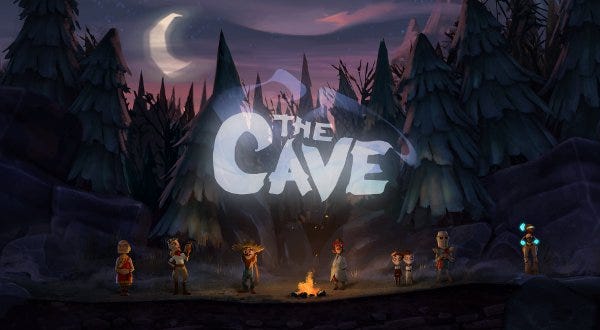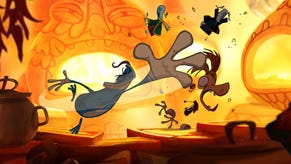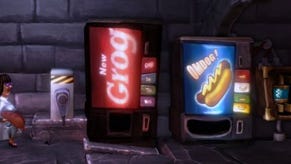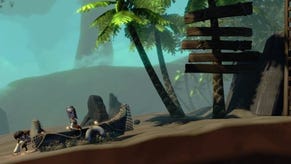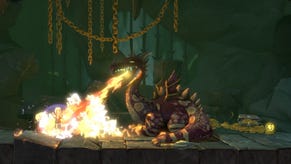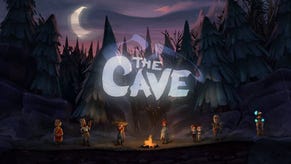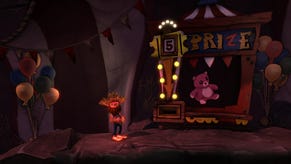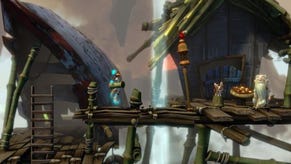Ron Gilbert Interview, Pt 1: All Things Cave-Related
"nobody liked Jeff"
You should be excited about The Cave. It is, after all, Monkey Island maestro Ron Gilbert's latest brainchild and - startling revelation that brains can have children aside - it looks to be a pleasant reminder that Double Fine's far, far more than just a one-trick Kickstarter pony. Also, and I can't stress this enough, the cave talks. So, after seeing it in action last week, I crept back into Double Fine's offices for a nice, long chat with Gilbert himself, who - much like your average magical cave - also talks. There, we discussed the game's parentage (Is Maniac Mansion the father? Shocking reveal on page 17), real life inspirations, why there's an odd number of main characters, the Cave's voice, and the reason Gilbert can never go on a whirlwind tour of the world's finest caves. Oh, and more, of course.
RPS: How direct is the link between The Cave and Maniac Mansion? Because there's the big similarity in terms of the multiple character dynamic. But was that a conscious decision, like "I want to revisit this thing that I did once and do it better"? Or is it purely coincidental?
Ron Gilbert: I don't think it was a very driven, conscious effort to revisit it. But I think for me, having multiple characters to go through something is just something I've always been interested in. It allows the players to experience something in a slightly different way the second time. They may play it, but then the replayability and... You know, you can tell the story slightly differently if you have different characters.
So I think it's something that's always interested me. The fact that there's seven characters in The Cave and there's seven characters in Maniac Mansion - that wasn't on purpose, but I think it falls out of the fact that seven is a really nice number. It just works so well in so many ways that I think it's just kind of the way that things naturally want to fall. Six doesn't feel like enough, eight just feels like it's too many. But seven! Of course.
RPS: During the presentation, you mentioned that you've been working on the Cave for about a year. But you joined up with Double Fine in 2010, right?
Ron Gilbert: I don't remember the exact dates...
RPS: Well, Wikipedia tells me 2010... [laughter]
Ron Gilbert: Well, well.
RPS: And it probably knows you better than you know yourself, so...
Ron Gilbert: Yeah, I'm trying to think, it was... Yeah, I don't remember exactly. But there was probably a six-month period from when I joined Double Fine and I knew I was to make the Cave, to when we actually got it signed by a publisher. So during that time, I was working on the design, pushing stuff out, but I don't really consider that "working on it," because at the time we had no team, we had no anything. It was just me. So that's probably where that six-month gap in my record comes from. [laughter]
RPS: How inspired is The Cave by real life experiences? I think at one point someone asked you a similar question during last week's presentation, and you said that you weren't sure exactly where it came from. But I would figure this sort of thing - something so human and emotionally grounded - has to come from someplace real, right?
Ron Gilbert: I'm very claustrophobic, so I certainly don't go into a lot of caves myself. Maybe I'm just acting out some latent fantasy by making a game about it. But I do think the thing about caves that's so interesting to us as human beings is just that I think they've been a part of our lives for hundreds of thousands of years, you know? They were shelter for us for a long, long time.
There's just something about caves that people find fascinating and mysterious. They're underground, which means they're dark and you're going down and there's all those metaphors of descending and going down into something that I think are just creatively really fun to play with. And also, one of the first adventure games I really got into was Colossal Cave, you know. On the old college mainframes. So that was kind of an early genesis, an early version of this game. It's, I don't know, 25 years old, but I came from really liking Colossal Cave and playing that a whole lot.
RPS: This one has been bugging me. There are seven characters. As you said, it's a nice number. But in terms of the structure of the game, you do three characters at a time, and so, in theory, you'd have to play the game three times, but one of the times would have two redundant characters. Is that how it works?
Ron Gilbert: Yes, I think mathematically that is how it probably works. I mean, you could play it with three and then you could play it a second time with one of the characters you played before and two new ones. Kind of mix and match that up. But yeah, you have to play it three times to see every single thing, and there is going to be some redundancy because of the characters. If we did nine characters instead of seven, then it wouldn't do that. But nine is just an odd number.
RPS: Are you worried at all about that, though? It seems like the type of game where once you've solved a puzzle, you know how to solve it. Wouldn't that hurt replayability?
Ron Gilbert: Well, I'm not that worried about it - just based on my experience of looking at how people played Maniac Mansion. Maniac Mansion was a game that I think people kinda grabbed on to characters they really liked. They liked Razor, they liked Bernard, nobody liked Jeff. But you know, they liked one of those characters. And so they would want to play with them. When they played Maniac Mansion again, they'd always bring Razor. They might bring some different characters, Michael or Wendy or whatever, but they always brought Razor because that was their favorite character.
I think people may do a very similar thing with The Cave, where they latch on to their favorite character. They love the Hillbilly or they love the Scientist. They're going to play it again, but they're going to play it with the Scientist, because they loved her area of the cave or they just loved her. Yeah, if you're min-maxing the completion of the game, then there's probably a couple of redundant ones. But I don't know that that's the way normal players really think about stuff.
RPS: So the cave talks, and that's really amazing and hilarious. But was that always the plan from the beginning? Or did that come out of some ridiculous brainstorming session at Double Fine or something?
Ron Gilbert: No, that was always part of the plan. That the cave really talks, that's he's kind of like the soul of the cave, this weird kind of omniscient presence that has witnessed through hundreds of thousands of years of people liking to go into caves. He's witnessed all of human evolution. It just seemed like an interesting character. Because of the amount of people that he's seen coming down here and their descendants, nothing surprises him anymore. Everybody's been down here at some point or another. I just thought that was an interesting kind of thing to play with from a story standpoint.
RPS: I think you mentioned that you haven't actually finalized a voice for the cave yet - even in terms of male or femaleness. So how do you envision The Cave as a character? Because those voices would bring a lot of different connotations depending on what you went with. What are you aiming for, and how would a different voice actor enhance that?
Ron Gilbert: It's kind of been a really hard search, because you want somebody who can embody that spirit that you think of as the Cave, but it also has to be a voice that has a certain weight to it. Not weight as in deep or resonating - just a weight to it because it's such an important character. Finding the right person for that is something we spent a lot of time trying to hone down and figure out.
RPS: If you'd started designing The Cave after the success of Double Fine Adventure, after that really took off, do you think it would still be an adventure platformer? Or do you think it would be more of a straight adventure game?
RG: Well, it's not really a platformer. It depends, I guess, on what your definition of a platformer is. The Cave, when you're playing the game, you are jumping, you are climbing up things, but that's really not the game. Nobody's going to miss a jump in this game, unless you're just completely screwing around. I very purposely do not want to make it a game that's about jumping, that's about barely grabbing ropes at the right time and getting all that stuff. The traversal part of the game is really just a fun activity.
I think one of the things that classic point-click adventure games were always criticized for was that walking around is boring. You had to walk from one end of Melee Island to the other end of Melee Island, and it's just boring to do. When we were developing Monkey Island, we had little cheat keys that would allow us to run as fast as we wanted, just because it was boring for us as the designers to run around the damn game. And so I think that kind of world traversal is something that's always been a little bit boring in adventure games.
Having the Cave be something that you're running around and you're jumping, you're climbing up things, wasn't really a way to add this whole other level of gameplay. It was just about making traversal fun and interesting and something you enjoy doing. If I had to run over here to get something, it was kind of fun to actually move over there and get that thing.
RPS: The puzzles that we've seen at this point are fairly simple, and they had to be, because you were just introducing the basic dynamics of the game. But how complex would you say they get? For instance, Fez recently came out, and that game had people stumped for days. But that was a very key part of the experience, and people ended up liking the fact that they were challenged so much by it. Would you say that The Cave is in that realm, or is it a bit less demanding?
Ron Gilbert: It's going to be a lot less demanding than that. And I think some of that just comes from who I am as a person now, you know? I have a lot of things that tug at my free time, and I don't enjoy games that I'm just stumped on for days on end like I used to. To me, having a game that's a good X hours that's just a really enjoyable experience to work your way through and learn about the story and learn about the characters and just see all the wonderful environments - to me, that's kind of what interests me a lot about gaming, rather than just incredibly hard, obtuse puzzles to work your way through.
I think Limbo did a really good job of that. I don't ever remember being stumped on Limbo for more than like five minutes or something. It's something that me and somebody could puzzle out in our heads in a few minutes. But it was just thoroughly enjoyable, because it was this wash of an experience that went over you while you were playing with it. It was really great.
RPS: Cave's playable characters - not the Cave obviously - but the characters you control, they're not voiced, right?
Ron Gilbert: Correct.
RPS: That's interesting, because Double Fine is a company that's always been very writing-oriented. That's a thing that people have associated with them for years. And also, you know, with adventure games, they tend to have a lot of amusing phrases and words and things.
Ron Gilbert: And things?
RPS: Words and things! Yeah! But I mean, what's it like trying to tell a story with that type of setup? What sort of challenges has that presented for you?
Ron Gilbert: Yeah, it's a real challenge. It was a much bigger challenge than I thought it was going to be when I first started. I actually thought that this was going to be super easy, because there's only one main character. But it ended up being really, really challenging, because you have a character where you're basically writing this kind of internal, running monologue that they're having. To kind of keep that interesting [was very difficult]. And there are other characters that you come across in the cave, besides those seven people, and those characters are fully voiced. So there is opportunity for other people to be talking and all this stuff, which helps a lot.
But I just felt that having those seven characters not talk was an interesting thing that lent a little bit to the mystery of who they really were, why they were here. It felt like if they never really verbalized any of those things, that it felt a little bit more like you were seeing it from the cave's perspective - of these people who just come in and do their thing. The Cave doesn't necessarily know exactly why they're here or what their motivations are either. It just felt nice to sync that up a little bit with the players. That the Cave and the players were on equal footing in terms of not really knowing who these people were or what they were doing.
RPS: There's no online multiplayer, right? So how is that going to transition onto the PC? Are you going to have a setup where everyone uses the same machine?
Ron Gilbert: Well, you can plug a controller into the PC. So if you do want to play with a controller you can play with that. If there's a second person, the second person will play with a controller while the other person plays with a more traditional interface.
RPS: The people who made Journey always went on about how they went and stayed in the desert for days before making the game. So clearly, you have to face your fears and go sleep in a cave for a week, right?
RG: Do you think that's really true? Did they really go out and stay in the desert?
RPS: I'm pretty sure they did. I talked with Robin [Hunicke] and she was very adamant about how much that influenced them.
Ron Gilbert: Well, you know, I'm really claustrophobic, so I can maybe stay in the mouth of the cave. That's about the most I can really get into a cave. I mean, I've been to caves - touristy caves, Carlsbad Caverns and stuff like that. And there were these really cool ice caves when I lived up in Seattle. Up in the Cascade mountains, there were these caves that were just these big, giant ice caverns that I went into a couple of times. But no, I don't plan on spending the night in a cave. Sorry. I guess I'm not true to my art.
PR representative who's been there the entire time: What if there's treasure?
Ron Gilbert: Oh, well then, [obviously]!
Check back tomorrow for part two, wherein we discuss everything non-Cave-related. That's right: everything. Ever.
